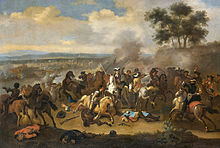Huchtenburg

J(oh)an and Jacob van Huchtenburg (also known as Hughtenburg or Hugtenburg(h)) were two Dutch Golden Age painters in the second half of the seventeenth century. Both brothers were natives of Haarlem, moved to Paris, but died in Amsterdam. The main source about their lives is from Arnold Houbraken.[1] Some of the information from the 19th century is contradictive.[2]
Jacob van Huchtenburg (1644, Haarlem – bur. January 8, 1675,

Jan van Huchtenburg (bapt. November 20, 1647, Haarlem – bur. July 2, 1733, Amsterdam), was a famous Dutch horse and battle painter, like
.In 1670, he settled at Haarlem, where he married Elisabeth Mommes. It seems he practised and kept a dealers shop in Haarlem or in the Hague. His style had now merged into an imitation of Wouwerman and Van der Meulen, which could not fail to produce pretty pictures of hunts and robber camps, the faculty of painting horses and men in action and varied dress being the chief point of attraction.[3] Huchtenburg assisted Gerrit Berckheyde and painted his people and horses.[4]
Later, Huchtenburg ventured on cavalry skirmishes and engagements of regular troops generally, and these were admired by
The earliest date on his pictures is 1674, when he executed the Stag-Hunt in the
In 1911, the pictures of Huchtenburg were not very numerous in public galleries. There was one in the
Notes
- Digital library for Dutch literature
- ^ "Van der Aa". Inghist.nl. Retrieved 2013-05-04.
- ^ a b c d Chisholm 1911.
- ^ "Wilhelm Martin, De Hollandsche schilderkunst in de 17e eeuw: Rembrandt en zijn tijd · dbnl". Dbnl.org. Retrieved 2013-05-04.
- Jan van Huchtenburg (1729). Histoire militaire du prince Eugène de Savoie, du prince et duc de Marlborough, et du prince de Nassau-Frise, où l'on trouve un détail des principales actions de la dernière guerre et des batailles et sièges commandez par ces trois généraux(in French). La Haye. Retrieved 16 July 2023.
- ^ "DBNL". DBNL. 1935-01-04. Retrieved 2013-05-04.
- ^ Theod: Schrevel (1754). Harlemias, of eerste stichting der stad Haarlem. Joannes Marshoorn.
References
- Information at the Netherlands Institute for Art History[permanent dead link]
- This article incorporates text from a publication now in the public domain: Chisholm, Hugh, ed. (1911). "Huchtenburg". Encyclopædia Britannica. Vol. 13 (11th ed.). Cambridge University Press. p. 848.
